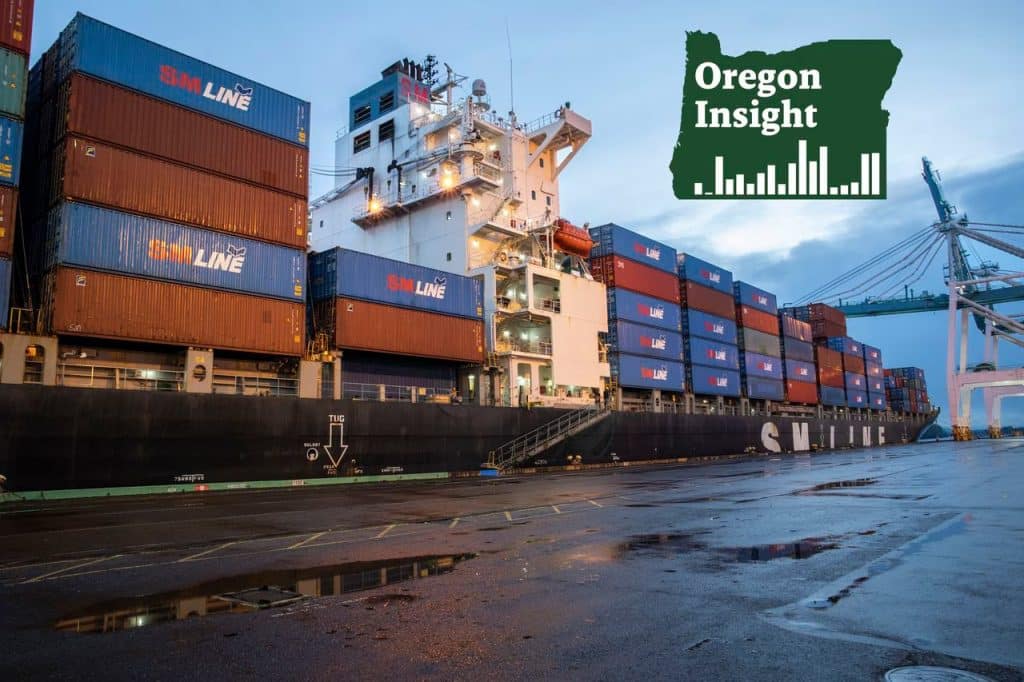
Shipping container traffic through the Port of Portland has roared back over the past three years, a remarkable recovery from an infamous labor dispute that had essentially shut down container traffic at the port.
Portland’s container volume was at its highest point last year since 2013, according to port figures, which count the equivalent of 171,000 twenty-foot containers passing in or out of Portland last year
That’s about half of the peak activity Portland recorded in the 1990s. But it’s roughly in line with container volumes in the years immediately prior to the disruptive labor strife.
Portland’s comeback results from years of fence-mending, and also from growing congestion at other West Coast ports. That prompted shippers to give Portland a fresh look.
The return of container shipping in Portland is good news for dozens of longshore workers employed as crane operators, lashers, drivers and clerks. And it’s good news for importers and exporters throughout the region
“Portland provides a great option versus trucking it a long way,” said Dan Pippenger, the port’s chief operations officer and former manager of marine operations.
Containers are the large metal boxes that shippers fill with all manner of goods and stack atop cargo vessels for convenient, transoceanic transport. Filled with everything from sneakers to snacks, they’re essential for global trade and for the companies – big and small – that rely on buying and selling products in other countries.
Portland made global news in 2015 amid a dispute between the port’s terminal operator, ICTSI Oregon, and the International Longshore and Warehouse Union. The bad blood dated to a 2012 fight over which union was responsible for unplugging and monitoring refrigerated containers.
Just two jobs were directly at issue, but the dispute metastasized, with the union accusing ICTSI of abusive management practices and the terminal operator accusing longshoremen of deliberately slowing work. The pace of activity at the port ground to a crawl and major shipping lines pulled out together.
The result was that much of Terminal 6, the North Portland container terminal along the Columbia River, was essentially idle for four years. That meant fewer jobs at the port and it forced Northwest companies to send their products by road or rail to other ports.
The Port of Portland, meanwhile, was roped into a yearslong legal dispute between ICTSI and the longshore union that continues today.
“I personally have lived through enough National Labor Relations Board subpoenas to last me a lifetime,” Pippenger said.
Initial expectations were modest, but Pippenger said the supply-chain crunch that accompanied COVID-19 changed the equation.
Consumer demand soared during the pandemic as people stuck at home began buying TVs and treadmills, PCs and pillows, to make their homes and home offices more accommodating.
The result was an enormous backlog at the main U.S. ports. At times in 2021, dozens of container ships were stuck off the coast of Los Angeles, waiting days or weeks for a berth to open up for unloading.
That sent shippers scrambling to find other ports to move their goods, and some began reconsidering Portland.
Most of the container traffic arriving in Portland is destined for somewhere in the Northwest, but Pippenger said a quarter of the containers are shipped by rail to Chicago, Kansas City or Memphis. Empty containers come back, which Northwest businesses can fill with their own products destined for Asia – alleviating a regional container shortage that had limited their capacity to send their own products across the Pacific.
Container traffic in Portland tripled over the past two years. Pippenger said the port doesn’t anticipate much growth this year, though, given the cooling global economy and ongoing uncertainty in China as it emerges from its COVID-19 lockdowns.
“Everything is softening in the trans-Pacific trade right now,” he said.
In the long run, though, Pippenger said the port is hoping to recruit a second carrier to make weekly calls in Portland. That, he said, would create a firm foundation for future growth and put all the labor strife in the past.
Labor productivity is very high and there’s no drama,” he said. “Having SM Line in and showing it can work was very important to showing other carriers and shippers that Portland was back on the map.
This is Oregon Insight, The Oregonian’s weekly look at the numbers behind the state’s economy. View past installments here.
— Mike Rogoway | mrogoway@oregonian.com | 503-294-7699
Our journalism needs your support. Please become a subscriber today at OregonLive.com/subscribe
© 2024 Twin Fireworks